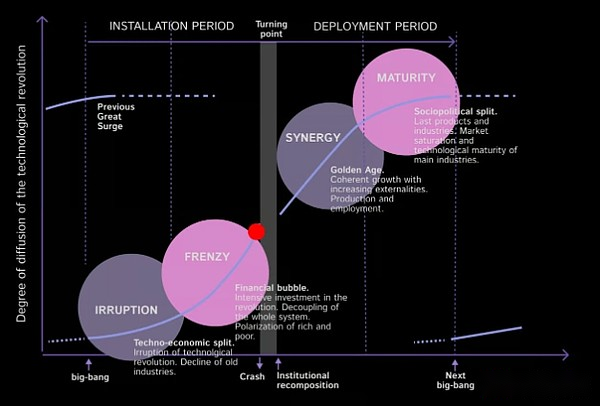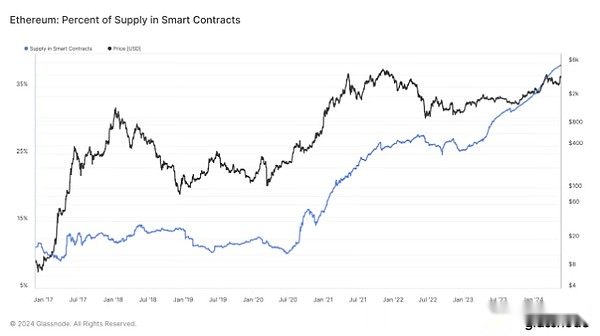
Author: Michael Nadeau, The DeFi Report; Compilation: Baishui, Bitchain Vision
Over the past year, we have been speculating that the crypto industry is approaching the turning point of its technological revolution.
Our ideas are influenced by the framework proposed in Carlota Perez’s book “Technical Revolution and Financial Capital.”
The core idea is,Revolutionary technologies usually go through 4 different stages during implementation and deployment: 1) explosion stage, 2) fanatic stage, 3) collaborative stage, 4) maturity stage.
The turning point between fanaticism and coordination.

The turning point usually occurs during the sequelae of the “crazy” period (cryptocurrency is 2021).This is after financial leverage is eliminated, consumers are hurt, fraud is revealed and lessons learned (2022/2023).
These “sober” periods tend to focus on regulation and policy making, marking the end of the setting period—and the beginning of the new technology deployment period.
In view of the events that happened last week, we think it is safe to officially announce nowWe have entered the turning point stage of cryptocurrency.Note that the red dot above touches fanatic and turning points.We think both may occur simultaneously in the cycle + after this cycle.
So, as the cryptocurrency industry enters a new paradigm, our DeFi report this week is leaning towards a stream of consciousness.
what happened?
The political influence began.
What is said here is obvious, but the Democrats seem to have miscalculated the popularity of cryptocurrencies in the United States.When you combine this with Biden’s poll performance + Trump’s recent alliance with the industry, you’ll see firsthand the political game theory taking place.
Now, both parties seem to be pleasing the cryptocurrency industry in the United States.
But as we wrote over a year ago, this has always been the case.Why?It is estimated thatMore than 50 million people in the United States own cryptocurrencies——This is a unique bipartisan user base.And because cryptocurrencies are financial in nature, the industry is turning Americans into single-issued voters.
That’s why the Democratic Party’s strategy makes no sense to us.They really messed up on this matter.
It all started with President Biden putting a puppet in the SEC, trying to hinder the industry through “law enforcement regulation?”.
Next, we see the Federal Deposit Insurance Corporation (FDIC) chair run “Operation Choke Point 2.0”.
Then Senator Warren’s “anti-cryptocurrency army?”
Everyone is seeking control.All failed strategies.
Meanwhile, the rest of us have been watching our industry shaking under the turmoil of political volatility and unelected bureaucracy.
It was frustrating to say the least.
But at the same time, democracy is winning.
For those who work within and support the industry.You all show that you have a say.You have agency rights.You should be proud of yourself.
Together we achieved it all.
Policymakers are listening.
So it seems that the Democrats (broadly speaking) no longer oppose cryptocurrencies:
-
12 Democrats (including Senate Majority Leader Chuck Schumer) voted last week to repeal SAB121, an SEC rule designed to prevent banks from providing crypto assets custody).
-
71 Democrats, including Nancy Pelosi, voted last week to pass the House of Representatives’ comprehensive legislation to pass the FIT21 bill.
-
The Democratic-led SEC (which should be independent) approved the ETH ETF.
-
Last week, Martin Gruenberg (the designer of Operation Choke Point 2.0) was forced to resign as FDIC chairman.
Although the battle is not over yet, it seems we have “crossed the gap” becauseCryptocurrencies are becoming a pillar industry in the United States.
This was consolidated last week.
ETH ETF
We have been looking forward to ETH ETFs since the Bitcoin product was approved.But we certainly didn’t expect it to pass last week.
Judging from the information we have, the Securities and Exchange Commission did not expect it.
How things happened:
To the best of our knowledge (James Seyffart interviewed Ryan Sean Adams), the SEC Marketing Department was ready to reject the ETH ETF Form 19b-4 around a week before approval.But somehow, the agency began to engage with issuers, who were equally surprised by that.Everyone was caught off guard.This makes no sense.
This leads us to think that the decision to approve the ETF is not from the SEC.It may come from somewhere else (probably the White House).
Now.We haven’t heard Gary Gensler comment on this topic yet.But we know that the decision was not made through the vote of 5 SEC commissioners – the BTC ETF was decided by them.This again suggests that the decision may have come from somewhere outside the SEC.
If so, who is managing the SEC?I know about 50 million Americans want to know.
Is it possible for Chairman Gensler to step down?Let’s wait and see.I can imagine that other SEC staff may be hard to believe his judgment now.
Some additional notes about ETFs:
-
We are still waiting for each issuer’s S1 form to be approved before we can start trading.This may take more than 4-6 weeks.
-
The approval of Form 19b-4 consolidates ETH’s position as a digital commodity (which could have a significant impact on other crypto assets and on Coinbase and Uniswap litigation).
-
19b-4 Approval does not include pledge.Therefore, the SEC may still regard pledged ETH as securities.
Market Outlook
Forecasting ETH ETF traffic
Bloomberg’s ETF experts (James Seyffart and Eric Balchunas) predict that ETH ETF traffic will account for about 10-20% of BTC ETF traffic.
What is logic?
-
Currently institutions are less interested in ETH.
-
ETH is harder to understand than BTC.
-
ETH Futures ETF trading volume is less than BTC (10-20%).
-
ETH spot trading volume is less than BTC (approximately 50%).
-
ETH accounts for about 1/3 of BTC’s market value.
Let’s assume that this view is correct.Since its launch, the net inflow of BTC ETFs has been around $13 billion.If ETH gets 10-20% net inflows, it means a net inflow of $1.3-2.6 billion.
Our opinion:
Given that BTC traded at about $40,000 after the launch of the ETF and rose to $70,000 two months later (75%), we expect a similar trend for ETH (pushing the asset past its all-time high of $4,800).
Having said that, ETH has several characteristics that distinguish it from BTC.The following points need to be kept in mind when we predict potential excellent performance of ETH:
-
ETH does not face “structural selling pressure” like BTC, because ETH validators do not incur operating expenses like Bitcoin miners (forcing them to sell a portion of the mined tokens).
-
Currently 38% of ETH supply is “soft locked” on the chain – earning profits in pledged contracts, DeFi applications, as collateral, etc.:

Source: Glassnode
-
Considering the percentage of on-chain supply, the exchange’s ETH balance is at its lowest level since 2016 (11% of circulating supply – below 11.8% of BTC):

Source: Glassnode
-
ETH is more reflexive than BTC.This reflexivity can be expressed through price action leading on-chain activity, resulting in more ETH being destroyed, which can further drive narrative, more price action, more on-chain activity and more ETH being destroyed.We think this will eventually lead to Larry Fink talking about Ethereum and its potential to become a new financial track on national television.
-
ETH is a technology game for web3 growth.”Call options” or “high growth index adopted by web3”.And Bitcoin is “digital gold”.For this reason, we believe ETH ultimately has a larger potential market than BTC.
-
ETH has excellent network effects and fundamentals while providing benefits to the pledgers of assets (not available to BTC holders).
Given the structural differences, we think it is wise to ask the following questions:
-
How many percentages of BTC ETF holders can rebalance to ETH?
-
How many percentages of investors can seek a 50/50 allocation of BTC and ETH?
-
How many percentages of investors can choose ETH instead of BTC directly?
-
If momentum hits, will ETH see the “reflexive flywheel” start?
-
How many institutions are currently on the wait-and-see state because they missed BTC?Will they devote all their efforts to ETH?
-
What happens if ETH gets 40-50% of BTC ETF traffic?
-
What would the “altcoin rotation” between ETF holders look like during this cycle?
Given our basic view of ETH, we believeETH is more likely to outperform Bloomberg10-20%Forecast of net inflow of BTC.
A simple framework for thinking about potential valuations of ETH (and BTC) in this cycle:
-
Cryptocurrency market capitalization is $10 trillion;
-
The BTC peak was 40% (43% in the previous cycle);
-
The ETH peak is 45% of the BTC market cap (50% in the previous cycle);
-
ETH at the peak of the cycle = $1.8 trillion
-
At the peak periodETHPrice is $14,984 (3.9 times)
-
*Suppose there has been no change in supply as of today
For reference,Bitcoin with a market capitalization of $4 trillion will be valued at $202,000 per BTC (2.8 times).Finally, the total market capitalization of $10 trillion is assumed to grow the same rate in the 2017/2018 cycle (388%) compared to the previous cycle.
*Bitcoin price is $150,000 (2.1 times), and ETH price is $11,200 (2.9 times) when other conditions are the same.
A broader market perspective
We try not to over-hype or over-confidence, but it is hard to imagine that cryptocurrencies have a more optimistic outlook now.Everything seems to be ready, including:
-
Innovation cycle.
-
Macro/liquidity cycle.
-
Election cycle.
-
Bitcoin halving cycle.
-
BTC and ETH ETF.
Now we have eliminated a key barrier because the market no longer needs to worry about Gary Gensler scorching the entire industry.
Therefore, we are increasingly convinced,encryptionThe market will continue to climb in the second half of the year and may peak in 2025.








